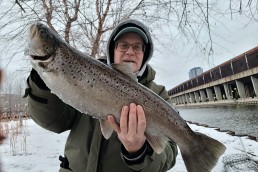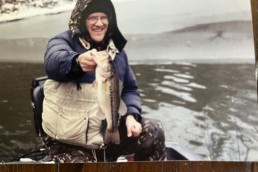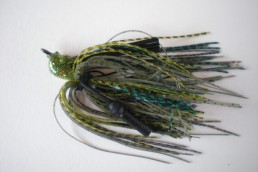Dropping the Hammer: Upsize your Finesse Rig for Hefty Rewards
SHARE THIS POST
Years ago on a summer bass-fishing adventure in the Land O’Lakes region, Joel, his youngest son Brandon and I stumbled onto the mother lode. Working a winding weed bed that spread over a 10- to 14-foot limestone shoal, we knew bass lived here. It was a popular early-season walleye community hole, but by midsummer its lush weeds swarmed with largemouths.
We plunged jigs and plastic baits into the grass, and to fix the lagging action, I rigged a drop-shot rig on a medium-heavy casting rod. I knotted a 1/2-ounce drop-shot weight to 20-pound-test fluorocarbon line and rigged it with a Jackall Craw to a 3/0 work hook. Twisting from shallow to deep locations over the shoal, I finally had a presentation working well in the grass. Over the next hour, numerous largemouths made it to the boat all on the heavy drop-shot rig.
At the very eastern end of this underwater shoal, the largemouths thinned out and we started catching smallmouths. Surprisingly, the smallies didn’t shy from the heavier tackle or Jackall and Yum craws. The smallies smashed it as fiercely as the bucketmouths. Nothing beats blasting 3-pound-plus smallmouths on heavy tackle. As the afternoon heat became heavy, the bite tapered off, but the confidence we gained strengthened my belief in heavy drop-shotting. As popular as drop-shotting is, few have strayed from the original finesse rigging.
An angler who is considered one of the best at it is FLW pro Cody Meyers. Meyers is from Auburn, Calif., and began his experimentation after poor results fishing traditional Texas-rigged baits.
“How I got started with heavy drop was watching everyone use the same beaver-style baits and big line in the California Delta; everyone was flipping and pitching down the bank. I knew I had to do something different to compete.”
Meyers added that drop-shotting is great for catching a lot bass and works well at catching big ones. Considering his largest bass on a drop-shot rig is over 12 pounds, he’s a firm believer in its abilities.
Same song, different singer
Drop-shotting has become a mainstay deep-water technique. The rigging is simple: Knot a 3/0 up to 5/0 worm hook onto the line with a Palomar knot, making sure you leave a lot of extra line with the tag line becoming your leader. Next, run the long tag end through the hook eye from the top and out the bottom—this keeps the hook rigid and vertical. Determine your leader length and knot the drop-shot weight in place. Snip off any extra line after affixing the weight. Most weights offer a wire clip that pinch onto the line. I suggest knotting the line around this wire. Jarring hook-sets can fling the weights free. A simple overhand knot will prevent constant re-rigging. Any worm hook will do, but Fastach and VMC offer swiveling worm hooks that mount the hook on a wire swivel.
Instead of the using one continuous section of line, simply knot the main line to the top end of the swivel and use a leader to attach the dropper weight to the hook. Many find the swiveling hook prevents line twist and are much easier to knot when in a rush. Large octopus or mosquito hooks for nose hooking are fine but don’t offer much protection against snagging. If you’re probing cover, stick to the worm hook.
Location
“You cannot go wrong with a drop shot,” declares Meyers. “It works throughout the seasons and catches fish anywhere.”
Are you enjoying this post?
You can be among the first to get the latest info on where to go, what to use and how to use it!
He adds that it makes baits work so naturally.
This beefed-up finesse presentation is not just for deeper water; it excels in shallow water too. Its only limitation is casting accuracy. Having the bait and weight apart from each other causes the rig to tumble in mid-cast. Sniper casts under trees, docks or other overhanging cover is best left for the other baits.
Any rocky area is drop-shot heaven. The dropper weight maintains bottom contract while the bait remains above potential snags. Adjust leader length to the mood of the fish; a few inches are all you’ll need if the bass are hugging the bottom or foraging on crawling crayfish. Lengthen the dropper up to a full 3 feet if bass are aggressive and chasing after baitfish. Bounce the rig over rocky points, isolated boulders or riprap areas and grass, and the heavier the cover the better. Dropping down a size or two in bait selection might make it more appealing to smallmouths. The heavy drop-shotting is just as deadly on smallies as the finesse version.
The knockout punch
Punch through heavy, matted grass demands the heaviest weights. Bullet weights in the 1- to 2-ounce class are required. Even tungsten—very dense alternative to lead—versions are massive, making this technique cumbersome. Executing hook-sets while rigged with a giant punching weight is never perfect. Bass often clamp down on the weight, preventing the hook from catching. Switching to a drop-shot ensures only the bait is swallowed and that the bulky weight remains dangling outside of the fish. Not only does this ensure near-perfect hook-sets but also dismisses the worry of bass being put off from the mammoth weight.
Another plus is that the bait remains visible when rigged. Bass buried under a canopy of weeds often suspend within the caverns. Jigs or Texas-rigged baits zip pass them and then settle in the cluttered bottom. Drop-shotting pierces most dense cover well, but also hovers the bait in the channel of open water between the mat and the lake’s bottom. Having the bait positioned above the bottom prevents it tangling in the gunk or surface debris.
Gearing up
This is the domain of baitcasting. Meyers selects a 7-foot 2-inch Shimano Cumara rod in medium-heavy action and matches that rod with a low-profile reel like the new Curado. He’ll then spool it with 20-pound-test Power Pro braided line. He links a fluorocarbon leader in 15 pounds with an Albright knot. He finds the fluorocarbon line is strategic for getting more bites. If the bite is difficult, he’ll downgrade to a 12-pound-test leader. Meyers prefers a 3/0 to 5/0 Gamakatsu straight-shank hook, which has a homemade keeper. Recently, bait keepers have been all the rage, and with good reason. The large barb on the hook shaft keeps soft plastics snuggly in place.
Subscribing to Cody’s gear choices, I prefer to use all fluorocarbon in clearer water or all braid in heavier cover. I stick to the heavier line to maintain greater control, but unlike Meyers, I’m not trying to pay a mortgage with every bass I catch.
Any traditional soft plastic bait will work with heavy drop-shotting. The bulk of my success has been with craws. This bait style is short yet bulky enough to hold a larger hook. Largemouths and smallmouths bite them with equal vigor, so I never need to worry about missing an opportunity.
Cody primarily uses a Roboworm, a staple in the West. He is equally affectionate toward Jackall’s 5.8-inch Flick Shake worm. Both are super-soft worms and are poured in a multitude of colors, offering tantalizing action. Regardless of bait style, this presentation is effective wherever the bass swim. And even though Cody is from the West Coast and has fished there a lot, his gear works amazingly well on northern bass in other places too.
MWO
SHARE THIS POST
Did you enjoy this post?
You can be among the first to get the latest info on where to go, what to use and how to use it!
Luigi De Rose
Luigi De Rose, has been crafting articles for the last 25 years. Loving anything fishing, especially bass fishing, Luigi has been lucky enough to fish on three continents. Currently, he is the bass editor at Ontario OUT of DOORS magazine and owner of IBASSIN.com, a blog decided to all things bass. His articles have graced the pages of Bassmaster, In-Fisherman and MidWest Outdoors to name a few. When not fishing, you can find him with his two girls and wife in the outdoors.



